![4 Types of Mixpanel Reports to Explore [+ Better Alternative] cover](https://blog-static.userpilot.com/blog/wp-content/uploads/2023/11/4-types-of-mixpanel-reports-to-explore_e149ad19d189fd109eb17d78460f231d_2000.png)
Mixpanel reports help you keep track of key metrics in your product analytics portfolio. That said, there are four different types of reports that you can generate with Mixpanel in just a few clicks. This guide will cover the different types of Mixpanel data!
Try Userpilot Now
See Why 1,000+ Teams Choose Userpilot

What are Mixpanel reports?
Mixpanel reports let you explore, analyze, and visualize data from your product, application, or website. Mixpanel has multiple report types, such as its Funnels, Flows, Retention, and Insights report, respectively.
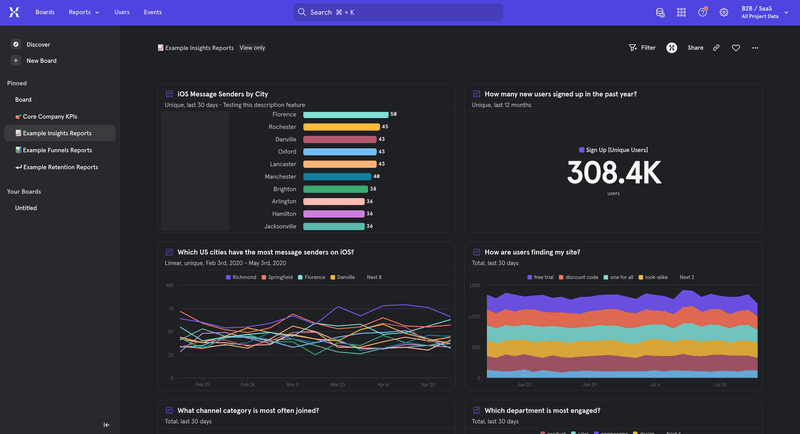
4 Types of Mixpanel reports
Because many users struggle to determine which Mixpanel report is right for them, we’re going to go over the four main types so you can figure out which one is ideal for your needs. The report types we’ll cover in the sections below are:
- Insights
- Funnels
- Flows
- Retention
Let’s take a closer look at each of these reports in the sections below!
Insights report
The Insights report, as the name implies, is used to gather actionable insights and visualize trends within these data sets. You’ll be able to analyze specific events, filter by cohort, and even narrow down to the individual user level.
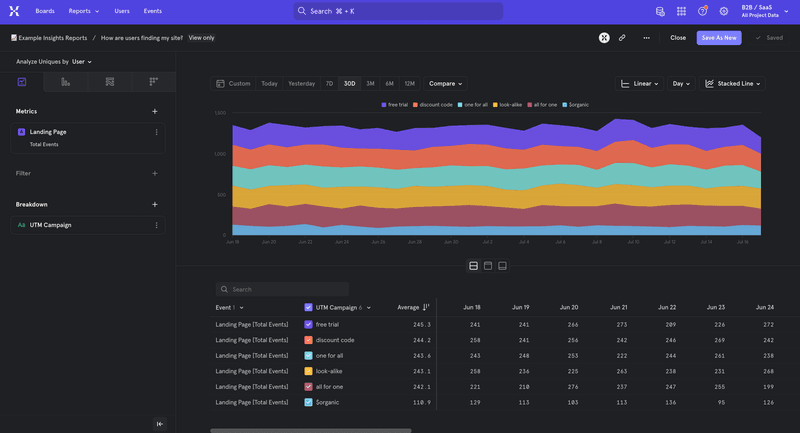
Report properties
Mixpanel Insights reports let you adjust:
- Formulas. Mixpanel lets you use formulas that add, subtract, multiply, or divide data.
- Visualization. There are multiple chart types that you can use to visualize your data. These include bar charts, pie charts, and table charts.
- Data comparison. The “Compare to past” button lets you select a previous time period or custom date range. This helps you compare key metrics to the baseline (e.g. average monthly traffic) or see how growth is trending.
- Custom events. Mixpanel’s custom events can be created from multiple standard events, combined with property filters, and then given a custom name. For instance, you could combine user signups and account creation.
What insights can you get?
Mixpanel Insights reports offer various insights by giving you answers to product-related questions. For example, you can find insights such as:
- How the number of daily active users (DAUs), weekly active users (WAUs), or monthly active users (MAUs) are changing over time.
- How your user base is spread across different countries, device types, or operating systems.
- How often users interact with your product, feature, or page. This type of analysis can be used to predict churn or project the growth of power users.
Funnel analysis report
The Funnels report is used to examine user behavior across a series of different steps. You can use funnel analysis to calculate the total number of users who made it from one funnel step to the next and display the conversion/drop-off rates for each stage.
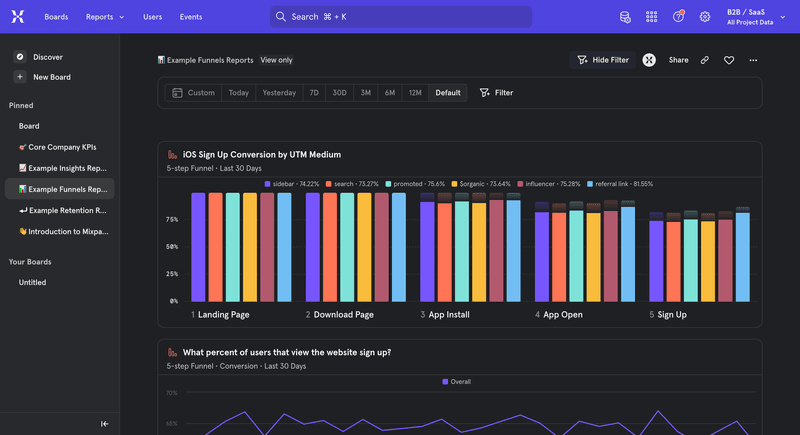
Report properties
When using Mixpanel Funnels reports, you can adjust the following attributes:
- Events. You could use events like page views, application installation, opened app, signed up/created account, etc.
- Breakdown. Reports can be broken down into groups based on which channel — with the in-product label of UTM Medium — users entered the funnel through.
- Visualization. By default, reports are visualized by funnel step. However, you can switch to charts for funnel trends, time to convert, or frequency analysis, depending on your use case.
- Exclusion steps. Exclusion steps are essentially a “didn’t perform action” filter for funnel reports. This can show you users who did events A and B but not event C.
What insights can you get?
You can use Mixpanel Funnels reports to gain insights into:
- The exact percentage of users who converted from your funnel within a certain time period (e.g. last seven days, month-to-date, or year-to-date).
- Conversion path analysis will highlight the exact path that a user takes between first opening your product versus making an initial purchase.
- Identify friction points and patch leaks hindering total revenue generated.
- Which user flows lead to conversions, and which flows don’t end with a purchase — or even cause churn.
Flows report
The Flows report is used to highlight the most common paths taken by your users before or after the occurrence of a specific event. These flow analytics can show you the series of events that your customers perform immediately preceding/following a key event.
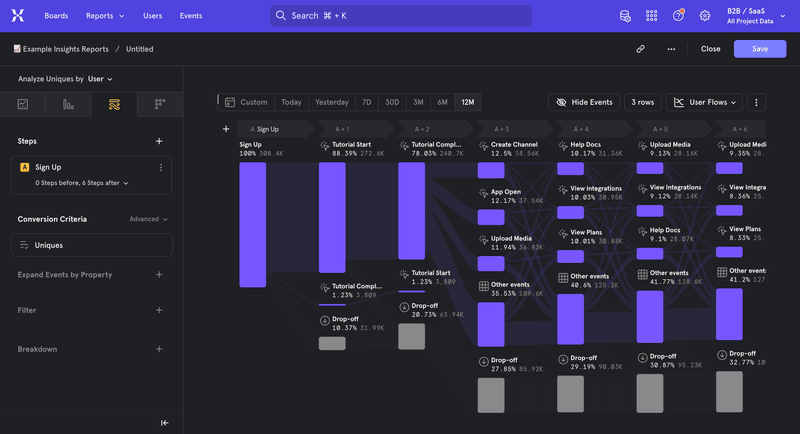
Report properties
Mixpanel Flows reports let you adjust:
- Events. You’ll be able to select which events you want to track the flow from/to when generating a report through your Mixpanel dashboard.
- Step count. You can set the number of steps you want to track before/after the event occurs. If you set it to “3 steps before” then you’ll see the three actions performed before an event.
- Filters. Filters let you exclude irrelevant data from your flow analysis. For instance, you could use the browser filter to only see events that were performed by a user on Chrome or customers using a specific device type.
- Breakdown. The breakdown setting lets you segment your flow data into groups.
What insights can you get?
Mixpanel Flows reports offer various insights such as:
- Which actions new users immediately perform after signing up for your SaaS platform.
- The exact set of actions that most users perform right after opening your application. These actions could show you how to turn more MAUs or WAUs into DAUs.
- The actions that led up to a customer having their Aha! moment or hitting other milestones in their customer journey.
- How users navigate from the initial signup process to their customer activation point. The user segmentation features can also be used to see how activation varies.
Retention report
The Retention report is used to assess the engagement level of different cohorts over a set time period. Retention analysis is essential for evaluating product-market fit (PMF) and ensuring that you can scale your business sustainably.
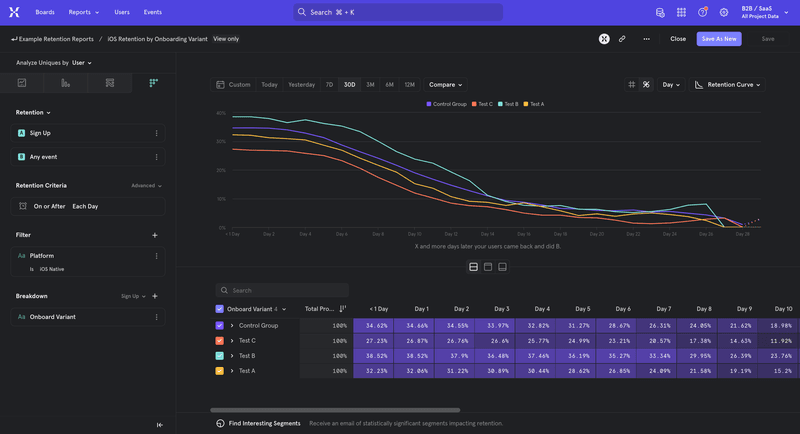
Report properties
Mixpanel Retention reports let you adjust:
- Events. Because you’re trying to measure retention for each user group, you’ll need to set “Sign Up” as the first event in your Mixpanel report. After that, you can select a specific event for the second step or set it to “Any Event.”
- Filters. Retention reports let you filter by various user attributes, such as device type. You could use this for cross-platform applications with differing retention rates for customers on each device type.
- Breakdown. Sticking with the iOS example, you could drill down further to see the retention rates for users with different application versions installed.
What insights can you get?
Mixpanel Retention reports offer various insights such as:
- Measuring how many people are still sending messages or creating tasks on your platform seven days after their signup date offers valuable insights.
- Seeing how your 7-day, 14-day, or 30-day retention rates change over time will give you an idea of what the trajectory of your product is.
- Seeing how many users used your product in two, three, or more separate sessions across their day will give you an accurate view of product stickiness.
How do you create a report in Mixpanel?
While Mixpanel offers several types of reports, most of them follow the same process. You start building your report by choosing the event you’d like to focus on, inserting filters or breakdown properties, and then adjusting the visualization type as you see fit.
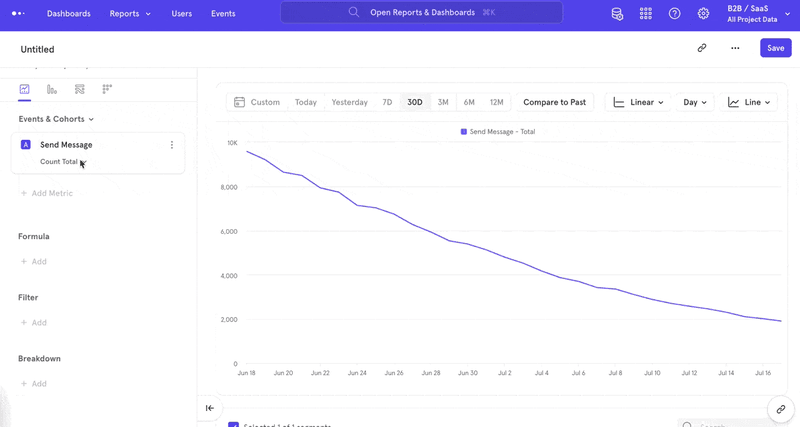
Pros and cons of Mixpanel analytics reports
Mixpanel enables anyone to take a single query and turn it into a detailed report in just a few clicks. However, there are a few notable pros and cons that you should be aware of before you sign up for one of their paid subscriptions.
Pros of Mixpanel reports
Mixpanel has a few unique benefits that make the platform an attractive choice:
- Cross-platform data. Mixpanel works on both website-based applications and mobile apps. This means you’ll be able to gather data from each platform and compare insights across different segments of your user base.
- Advanced analytics. Mixpanels’ analytics work out of the box while letting you create customized reports later on. Sadly, you can only view insights rather than act on them with product experiments or in-app guidance.
- Data residency. Mixpanel offers the option to process and store all customer data within Europe through the EU Data Residency Program. This ensures compliance regardless of which continents your data sources come from.
Here’s what Mixpanel customers have to say about its benefits:
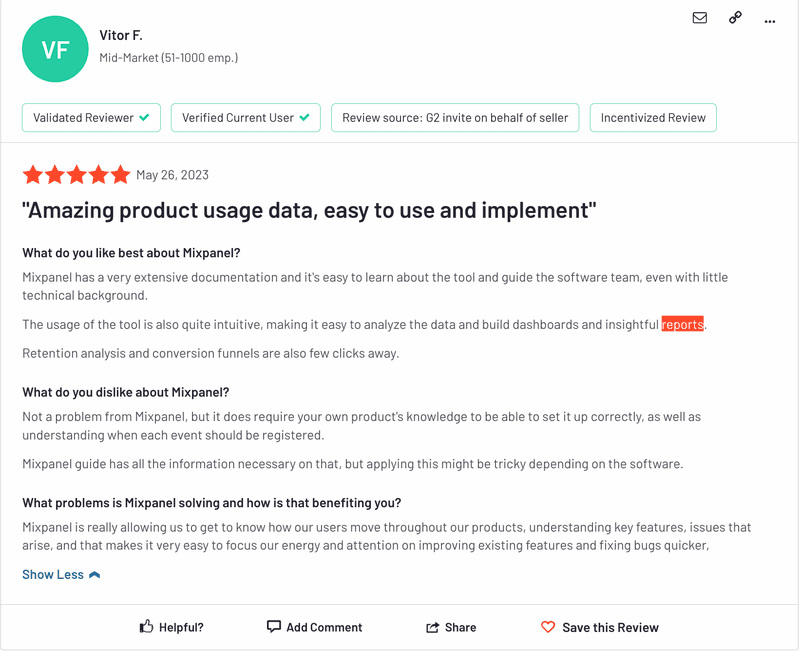
Cons of Mixpanel reports
Of course, there are also a few drawbacks that may make you think twice before using Mixpanel:
- Manual reporting. Mixpanel doesn’t automatically generate any reports from the data it collects. As such, you’ll need to manually create each report. In contrast, Userpilot has auto-generated product analytics and user insights.
- Learning curve. The complexity of the product and the lack of auto-generated reports make for a pretty steep learning curve. New organizations may not know how to navigate the platform or which reports they should build.
- Pricing model. Mixpanel’s pricing can get rather pricey, even for medium-sized companies. The price increases even further once you scale the size of your company/user base. In fact, the enterprise plan starts at $833/month.
Here’s what Mixpanel customers have to say about its drawbacks:
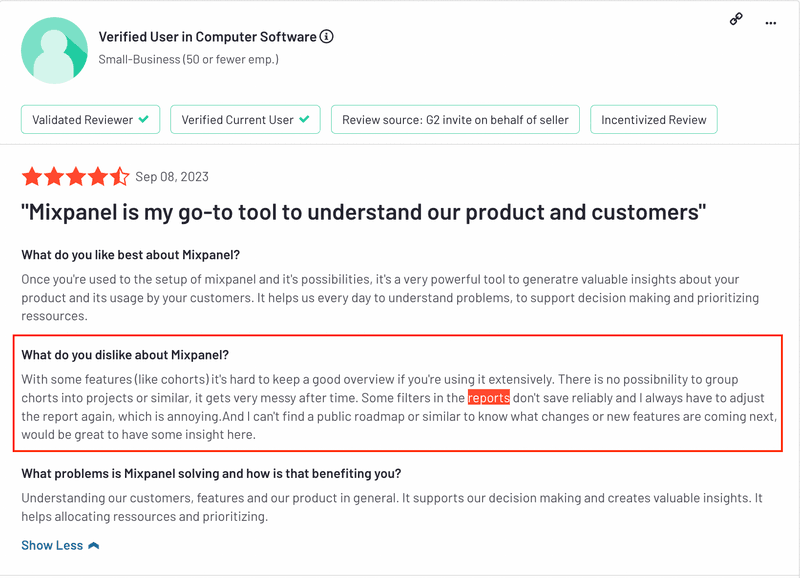
Is Mixpanel better than Google Analytics?
Mixpanel is a better option for SaaS, while you may find Google Analytics more suitable to track marketing and e-commerce metrics. All in all, the comparison of Mixpanel vs Google Analytics comes down to a few differences:
- Google Analytics shows you how people get to your website while Mixpanel shows you what they do once there.
- Setting up a funnel analytics dashboard in GA4 is similar to Mixpanel in terms of setting up steps, but you can’t analyze user paths up to 4 pages at a time at a glance on Mixpanel.
- You can monitor retention cohort changes in Mixpanel using a comparison baseline, while GA4 allows you to analyze retention by seeing differences in active users, event count, transactions, or purchase revenue.
- Both platforms have a free option, but Mixpanel’s paid plans can get expensive as you scale up.
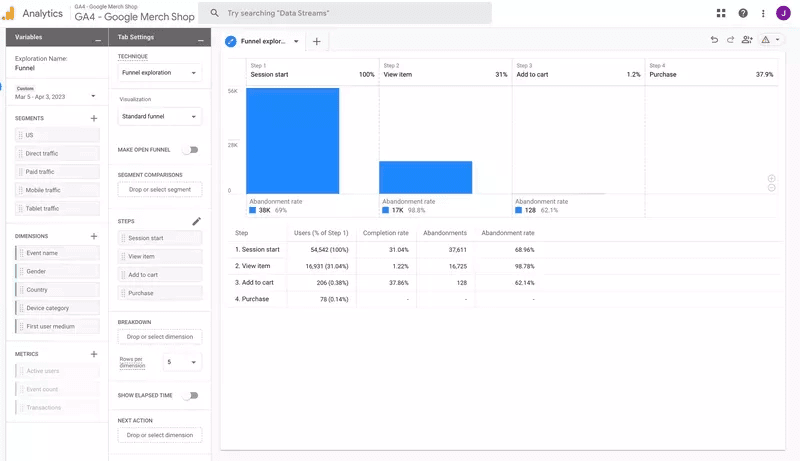
How much does Mixpanel cost?
Mixpanel pricing on its paid plans ranges from $20/month to $833/month, depending on which subscription tier you get. That said, the monthly cost rises as you scale up. Mixpanel does offer a freemium plan but this limits the event volume and features.
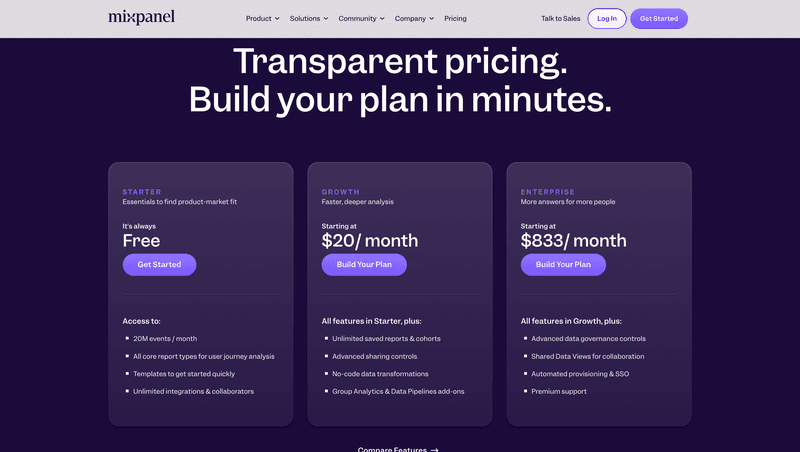
Userpilot – A better alternative to Mixpanel reports
Not all product analytics tools are created equal, and Mixpanel is certainly no exception. Mixpanel’s largest shortcoming is the fact that it doesn’t let you act on any of the insights it gathers. In contrast, adoption platforms like Userpilot build no-code flows.
In addition to letting you A/B test using first-party data, Userpilot is able to automatically generate reports on your most important product metrics or event properties. Let’s take a closer look at Userpilot’s report types and pricing plans below.
Userpilot reports
Userpilot has funnel, trend, retention, and path reports. These report types offer a wide variety of analytics that help you monitor drop-off rates, data trends, retention rates, and user paths.
Here’s an overview of Userpilot’s reports:
- Funnels. Funnel analysis reports help you identify drop-offs and friction points so you can optimize the user experience across each step. You’ll also be able to adjust the date range and see the funnel’s average conversion time.
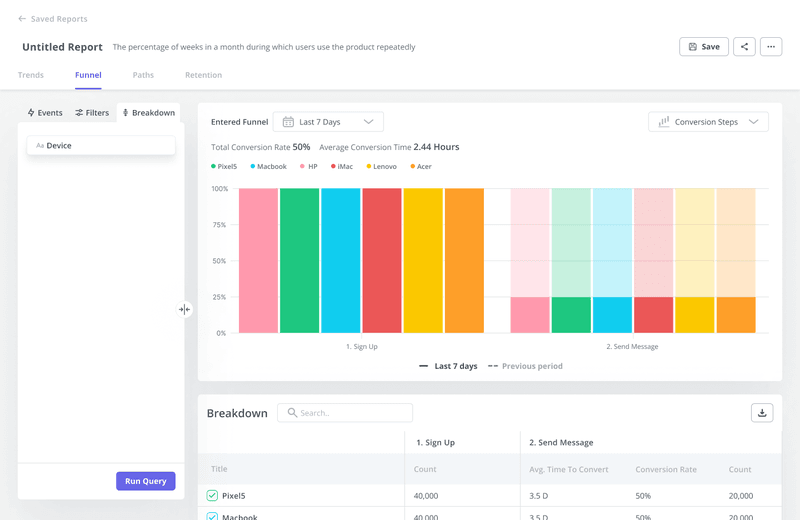
- Trends. Trend reports help you compare user behavior from different date ranges and see how data changes over time. You can set the intervals (daily, weekly, monthly, etc.) and narrow data down to different time periods.
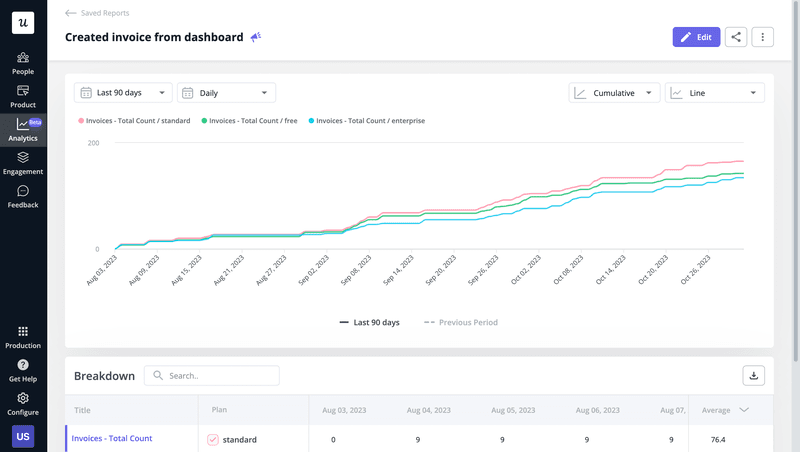
- Retention. Retention reports help you calculate retention, predict churn, and reduce churn over time. The retention table also lets you see how different cohorts are progressing from week to week at a glance.
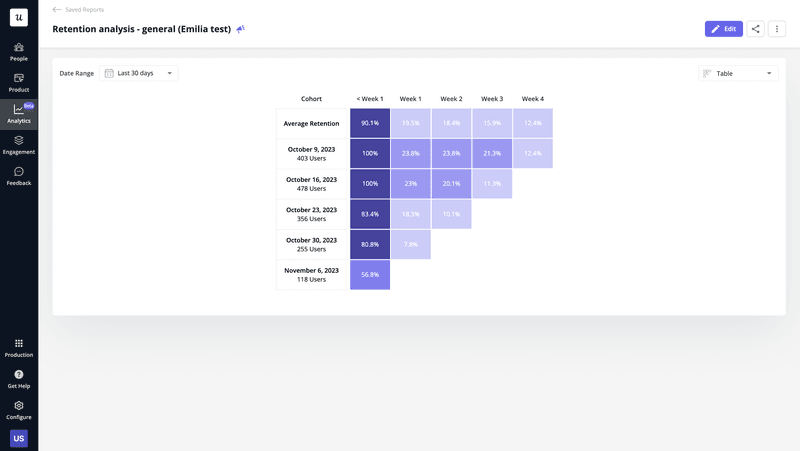
- Paths. Path analysis reports help you analyze the customer journey and track how users navigate within your product. You’ll be able to set your path starting point, tracked feature/event, and conversion criteria as needed.
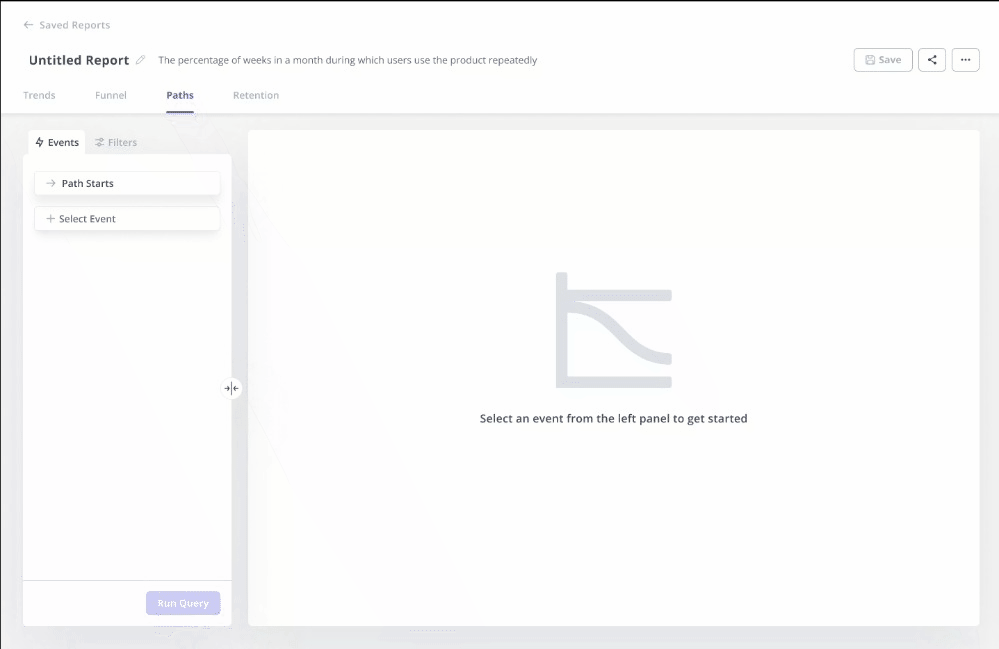
Userpilot pricing
Userpilot offers flexible pricing based on your monthly active users (MAUs). Plans start at $299 per month for smaller teams and scale as your user base grows.
Below are the pricing tiers you can choose from:
- The Starter plan begins at $299/month (billed annually) for up to 2,000 monthly active users. It includes in-app user engagement, usage trend analysis, NPS surveys, and essential product analytics—ideal for mid-market SaaS teams getting started.
- The Growth plan offers custom pricing and adds advanced analytics, retroactive event auto-capture, in-app surveys, session replay, and more. It’s the most popular choice for growing teams that need deeper insights and scale.
- The Enterprise plan offers custom pricing and includes everything in Growth, plus bulk data handling, custom roles and permissions, SOC 2 Type 2 compliance, and enterprise-level support.

Conclusion
As you can see, Mixpanel has a wide range of event properties and report settings that you can adjust based on your specific needs. Whether you want to see your most important metrics through custom dashboards or track cross-platform data.
That said, Userpilot is a more flexible platform since it lets you respond to the insights you uncover using no-code flows that guide and engage users. If you’re ready to start acting on your data, then it’s time to get your free Userpilot demo today!





